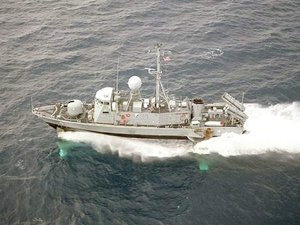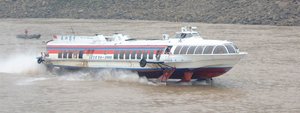Hydrofoil
|
|
Jetfoil_Toppi_001.JPG
A hydrofoil is a boat with wing-like foils mounted on struts below the hull. As the craft increases its speed the hydrofoils develop enough lift for the boat to become foilborne - i.e. to raise the hull up and out of the water. This results in a great reduction in drag and a corresponding increase in speed.
Early hydrofoils used U-shape foils. Hydrofoils of this type are known as surface-piercing since portions of the U-shape hydrofoils will rise above the water surface when foilborne. Modern hydrofoils use T-shape foils which are fully-submerged. Fully submerged hydrofoils are less subjected to the effects of waves, they are therefore more stable at sea and are more comfortable for the crew and passengers. This type of configuration however is not self-stabilizing. The angle of attack on the hydrofoils need to be adjusted continuously in accordance to the changing conditions, a control process that is performed by computers. Failure to make the proper adjustments will result in the foilborne hull dropping violently back into the sea.
MeteorHydrofoil.jpg
A March 1906 Scientific American article by American hydrofoil pioneer William E. Meacham explained the basic principle of hydrofoils. Alexander Graham Bell considered the invention of the hydroplane a very significant achievement. After reading this article Bell began to sketch concepts of what is now called a hydrofoil boat. With Casey Baldwin he began hydrofoil experimentation in the summer of 1908. Baldwin studied the work of the Italian inventor Enrico Forlanini and began testing models based on his designs. This led him and Bell to the development of hydrofoil watercraft. During Bell's world tour of 1910-1911 he and Baldwin met with Forlanini in Italy. They had rides in the Forlanini hydrofoil boat over Lake Maggiore. Baldwin described it as being as smooth as flying. On returning to Baddeck a number of designs were tried culminating in the HD-4. Using Renault engines a top speed of 54 mph (87 km/h) was achieved, accelerating rapidly, taking wave without difficulty, steering well and showing good stability. Bell's report to the United States Navy permitted him to obtain two 350 horsepower (260 kW) engines. On September 9, 1919 the HD-4 set a world marine speed record of 70.86 mph (114 km/h). This record stood for ten years.
Baron von Schertel worked on hydrofoils prior to and during World War II in Germany. After the war Schertel's team was captured by the Russians. Schertel himself went to Switzerland, where he established the Supramar company. In 1952, Supramar launched the first commercial hydrofoil, PT10, in Lake Maggiore, between Switzerland and Italy. The PT10 is of surface-piercing type, it can carry 32 passengers and travel at 35 knots. From 1952 to 1971, Supramar designed many models of hydrofoils: PT20, PT50, PT75, PT100 and PT150. Except the PT150, all are of surface-piercing type. Over 150 of Supramar's design were built, most of them by Rodriquez in Italy. Hitachi in Japan had also built some under license.
The Soviet Union experimented extensively with hydrofoils, constructing hydrofoil ferries with streamlined designs, especially during the 1970s and 1980s. Such vessels include the Meteor type and the smaller Voskhod type; these vessels have inspired people in the former Soviet Union to continue tinkering with hydrofoils and selling them to hydrofoil operators.

The U.S. Navy operated combat hydrofoils, such as the Pegasus class, from 1977 through 1993. These hydrofoils were fast and well armed, and were capable of sinking all but the largest surface vessels. In their narcotics interdiction role, they were a nightmare for drug runners, being very fast, and having missiles and guns to stop anything they could not catch, as well as the ability to call in air support.
Some operators of hydrofoil include:
- Turbojet Ferry, which speeds passengers across the Pearl River Delta between Hong Kong and Macau in just over an hour, with an average speed of 60 knots (110 km/h). Also services Shenzhen, Guangzhou and Kowloon. Operated by Shun Tak-China Travel Ship Management Limited.
- Meteor service between St. Petersburg and Peterhof, Peter the Great's Summer Palace.
Hydrovessel.jpg
See also
External link
- Boeing's Jetfoil (http://www.boeing.com/history/boeing/hydro.html)
- Turbojet - Hong Kong to Macau Ferry (http://www.turbojet.com.hk)
- Human powered hydrofoil examples (http://www.foils.org/gallery/misc.htm)
- The International Hydrofoil Society (http://foils.org)
- Kawasaki Jetfoil (http://www.kjps.co.jp/english/eindex.html)de:Tragflächenboot
it:Aliscafo ja:水中翼船 nl:Draagvleugelboot sv:Bärplansbåt zh:水翼船

